Books for the Native Plant Gardener
Many of the books listed here are available for purchase during Chapter plant sales and events.
Fundamental Books
We think these are books that every native plant gardener should have. Some are available in libraries, and available for purchase during our Chapter plant sales and events.
|
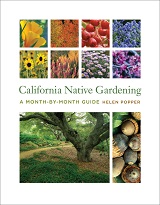 |
CALIFORNIA NATIVE GARDENING, A MONTH-BY-MONTH GUIDE. Helen Popper. University of California Press (2012). 217 pp, paperback. Helen Popper is a long-time member of the Santa Clara Valley chapter of the California Native Plant Society and was one of the first members of the chapter's Gardening with Natives group. She was the note taker at the group's early monthly meetings, and this book is a compilation of the knowledge of the group's members from those meetings. It provides a useful roadmap of the tasks that need to be covered each month to create and maintain a native plant garden. Popper has given talks about these concepts for our chapter. You can view one of them here.
|
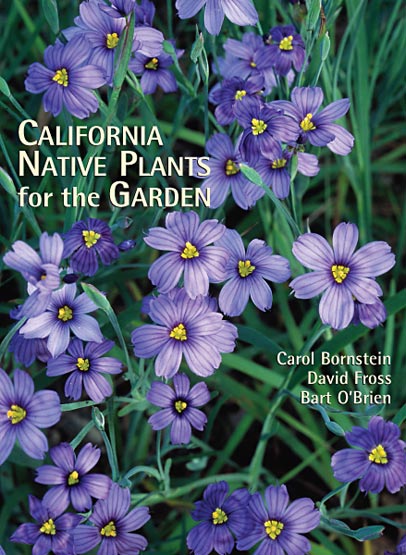 |
CALIFORNIA NATIVE PLANTS FOR THE GARDEN. Carol Bornstein, David Fross, Bart O'Brien. Cachuma Press (December 1, 2005). 280 pp, paperback & hardback. This comprehensive resource features more than 500 of the best California native plants for gardening. Written by three of the state's leading native-plant horticulturists and illustrated with 450 color photos, this reference book also includes chapters on landscape design, installation, and maintenance. Detailed lists of recommended native plants for a variety of situations and appendices with information on places to see native plants and where to buy them are also provided. |
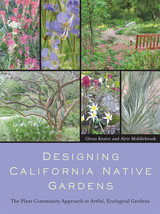 |
DESIGNING CALIFORNIA NATIVE PLANTS GARDENS: THE PLANT COMMUNITY APPROACH TO ARTFUL, ECOLOGICAL GARDENS. Glenn Keator and Alrie Middlebrook. University of California Press (June 4, 2007). 352 pp, paperback. This book was created with the aim of conveying the awesome diversity and beauty of California's native plants and demonstrating how they can be brought into ecologically sound, attractive, workable, and artful gardens. Structured around major California plant communities--bluffs, redwoods, the Channel Islands, coastal scrub, grasslands, deserts, oak woodlands, mixed evergreen woodlands, riparian, chaparral, mountain meadows, and wetlands--the book's twelve chapters each include sample plans for a native garden design accompanied by original drawings, color photographs, a plant list, tips on successful gardening with individual species, and more. |
Useful References
|
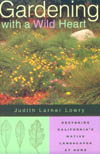 |
GARDENING WITH A WILD HEART. Judith Larner Lowry. University of California Press (1999), Berkeley, CA. 252 pp, softback. A compelling investigation into the whys and hows of gardening with native plants. Its engaging style mixes personal history, botany, anthropology, and ecology, and brings it all to bear on what you could be doing in your yard. This book has inspired many to practice restoration gardening. |
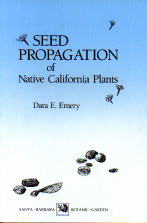 |
SEED PROPAGATION OF NATIVE CALIFORNIA PLANTS. Dara Emery. Santa Barbara Botanic Garden, Santa Barbara, CA. 115 pp, softback. An extensive table lists germination and propagation requirements of hundreds of native species. |
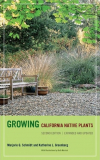 |
Growing California Native Plants, Second Edition. Marjorie G. Schmidt (Author), Katherine Greenberg (Author), Beth Merrick (Illustrator). University of California Press, Berkeley, CA. 296 pages, softback. March 26, 2012. This book is still at the top of the heap when it comes to books on native plant gardening. Written for the gardener, the book covers a wide variety of native plants, their characteristics, culture information, and estimate of garden value. This is a must-have book for beginners and experts alike. |
 |
COMPATIBLE PLANTS UNDER AND AROUND OAKS. Bruce Hagen et al. California Oak Foundation, 1212 Broadway, Suite 810, Oakland, CA 94612. 69 pp, softback. Out of print, but available as a free download. |
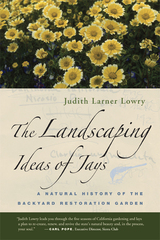 |
THE LANDSCAPING IDEAS OF JAYS: A NATURAL HISTORY OF THE BACKYARD RESTORATION GARDEN. Judith Larner Lowry. University of California Press, 2007. 292 pp, softback. Elegantly organized by season, this lyrical yet practical guide to backyard restoration gardening celebrates the beauty, the challenges, and the rewards of growing native plants at home. Drawing on her experiences in her own garden, Lowry offers guidance on how to plan a garden with birds, plants, and insects in mind; how to shape it with trees and shrubs, paths and trails, ponds, and other features; and how to cultivate, maintain, and harvest seeds and food from a diverse array of native annuals and perennials. Lowry shares the delights of creating site-specific, ever-changing gardens that can help us better understand our place in the natural world. |
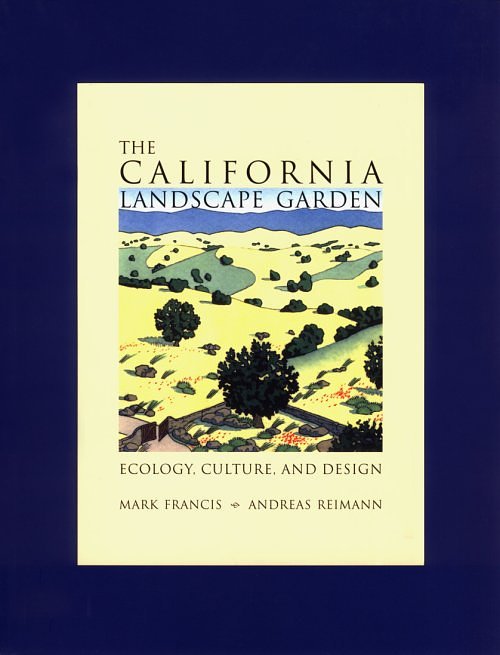 |
THE CALIFORNIA LANDSCAPE GARDEN: ECOLOGY, CULTURE, AND DESIGN. Mark Francis, Andreas Reimann. University of California Press. 1999. 254 pp, hardcover. The beauty, resources, and natural processes of the California landscape are brought to the home garden in Mark Francis and Andreas Reimann's fine testament to ecological gardening. The authors connect history, culture, region, and design to help us understand how California and its human population have evolved historically and how individuals today can make a difference in the state's future in their own backyards. They provide essential information on native plants and wildlife, ecology and bioregionalism, landscape history and design concepts, as well as numerous examples showing how to integrate environmental principles in one's garden. This is a book for anyone seeking a garden philosophy that is environmentally sensitive, and even experienced home gardeners, landscape professionals, and horticulturists will find new and useful material here. |
CLASSIC REFERENCES
|
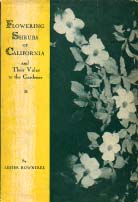 |
FLOWERING SHRUBS OF CALIFORNIA AND THEIR VALUE TO THE GARDENER. Lester Rowntree. Stanford University Press. 1939. One of the earliest and best written books on native plants. Worth looking for in used book stores. |
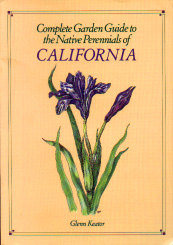 |
NATIVE PERENNIALS OF CALIFORNIA. Glenn Keator. Chronicle Books, San Francisco, CA. 303 pp, softback. This out-of-print book is worth hunting for in used bookstores for its encyclopedic content. |
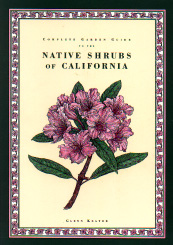 |
NATIVE SHRUBS OF CALIFORNIA. Glenn Keator. Chronicle Books, San Francisco, CA. 314 pp, softback. A handy reference on woody native plants. A particularly useful section is the appendix on commonly available cultivars. |
NATURAL HISTORY & ETHNOBOTANY
|
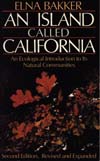 |
AN ISLAND CALLED CALIFORNIA. Elna Bakker. University of California Press. 400 pp, softback. A classic reference which connects the native flora, fauna, climate, and geography of each biotic community in the state. |
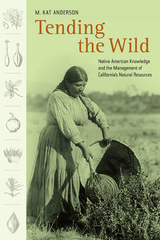 |
TENDING THE WILD: NATIVE AMERICAN KNOWLEDGE AND THE MANAGEMENT OF CALIFORNIA'S NATURAL RESOURCES. M. Kat Anderson. University of California Press, 2006. 555 pp, paperback. John Muir was an early proponent of a view we still hold today--that much of California was pristine, untouched wilderness before the arrival of Europeans. But as this groundbreaking book demonstrates, what Muir was really seeing when he admired the grand vistas of Yosemite and the gold and purple flowers carpeting the Central Valley were the fertile gardens of the Sierra Miwok and Valley Yokuts Indians, modified and made productive by centuries of harvesting, tilling, sowing, pruning, and burning. Marvelously detailed and beautifully written, Tending the Wild is an unparalleled examination of Native American knowledge and uses of California's natural resources that reshapes our understanding of native cultures and shows how we might begin to use their knowledge in our own conservation efforts. Tending the Wild persuasively argues that this traditional ecological knowledge is essential if we are to successfully meet the challenge of living sustainably. |
Where to Buy Native Plant Seeds
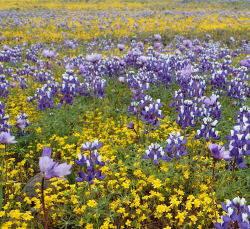 Late fall and winter are the best times to sow native plant seeds. Online sources offer the widest selection of native plant seeds, but it is possible to find them in local stores. It often takes a little searching to find them -- here are some tips here to help you locate them. If you know of seed sources in the Bay Area that are not included on this page, please send updates to This email address is being protected from spambots. You need JavaScript enabled to view it..
Late fall and winter are the best times to sow native plant seeds. Online sources offer the widest selection of native plant seeds, but it is possible to find them in local stores. It often takes a little searching to find them -- here are some tips here to help you locate them. If you know of seed sources in the Bay Area that are not included on this page, please send updates to This email address is being protected from spambots. You need JavaScript enabled to view it..
Bay Area Stores where native seeds have been spotted
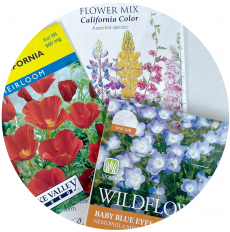 Many nurseries and even big box hardware stores carry a limited number of native plant seeds and seed mixes, but it can be challenging trying to find packets of seed mixes with only natives as many mixes that include "California" in the name include non-native seeds. It's important to carefully read the list of included flowers before buying. We've identified two native seed mixes that have been spotted in Bay Area stores:
Many nurseries and even big box hardware stores carry a limited number of native plant seeds and seed mixes, but it can be challenging trying to find packets of seed mixes with only natives as many mixes that include "California" in the name include non-native seeds. It's important to carefully read the list of included flowers before buying. We've identified two native seed mixes that have been spotted in Bay Area stores:
Both of these companies also offer seed mixes with similar names that contain non-native plant seeds, so be sure to check carefully before purchasing.
Stores where these and other native seeds and native seed mixes have been found:
- Almaden Valley Nursery,15800 Almaden Expy, San Jose - Carries Botanical Interests seeds. Look for "California Color Flower Mix Seeds". There are a number of other mixes that include the word "California" in the name, but contain non-native species.
- CNL Native Plant Nursery, 254 Shoreline Hwy, Mill Valley - Variety of native seeds, many of them locally grown and packaged.
- Home Depot - Carries Stover seeds. Look for "California Native Wildflower Mixture". Available in 1.5oz and 10gm. There are several similarly named Stover mixes that contain non-natives, so be careful. You can also order directly from Stover.
- Summerwinds - Carries Botanical Interests seeds. Look for "California Color Flower Mix Seeds". There are a number of other mixes that include the word "California" in the name, but contain non-native species.
- Watershed Nursery, 601 A Canal Blvd., Richmond - Carries a nice selection of locally grown native seed mixes.
- Yerba Buena Nursery, 12511 San Mateo Rd. (Hwy 92), Half Moon Bay. Good selection of seeds.
Availability changes frequently, so call ahead or ask at the information desk if you have trouble locating seeds.
California Poppies
 The most commonly available native plant seeds are California poppies. Since there are many non-native poppies, make sure the botanical name is "Eschscholzia california" when choosing poppy seeds. In addition to the well known orange California poppies, California poppy seeds are available for a rainbow of other colors. Some commonly available ones include:
The most commonly available native plant seeds are California poppies. Since there are many non-native poppies, make sure the botanical name is "Eschscholzia california" when choosing poppy seeds. In addition to the well known orange California poppies, California poppy seeds are available for a rainbow of other colors. Some commonly available ones include:
- Mission Bells - a double/semi-double variety with a rainbow of colors - white, orange, red, yellow and rose.
- Mikado - scarlet-orange
- Sundew - lemon-yellow
Online vendors with a wide selection of California poppies:
Online Seed Stores
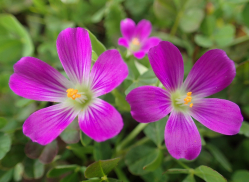
CANativeSeeds - Online seed store based in Castro Valley.
Larner Seeds; PO Box 407 or 235 Grove Road; Bolinas 94971; (415) 868-9407; Mail order seeds and California native wildflowers, perennials, grasses, shrubs, and trees. Retail plants at the nursery from October through July.
Natureseed.com: Natureseed.com took over distribution for Pacific Coast Seed and Hedgerow Farms. They also carry seeds from a variety of other sources, so it's important to read the species list carefully when you are buying mixes as many of them include non-native seeds.
San Diego Chapter, California Native Plant Society seed store; San Diego, CA, Contact Form; Sells California native seeds primarily from Southern California in small quantities for home and demonstration gardens
Seedhunt; PO Box 96, Freedom 95019; Mail order annual and perennial seed with hard to find selections and about one-third native
The Theodore Payne Foundation for Wildflowers and Native Plants Inc.;10459 Tuxford Street, Sun Valley 91352, (818) 768-1802; Online ordering available for seeds. Many useful plant resources on the site
S&S Seeds; P.O. Box 1275, Carpinteria, CA 93014; (805) 684-0436; Wholesale seeds, with $150 minimum order.
Stover: Seeds are often also available at Home Depot. In addition to "California Native Wildflower Mixture" they often have Narrow-Leaved Milkweed (Asclepias fascicularis), Baby Blue Eyes (Nemophila menziesii), Blue Flax (Linum lewisii), Desert Bluebells / California Bluebells (Phacelia campanularia).
Basics of Gardening for Habitat
Understanding the Basics of Gardening for Habitat
What Brings Bees, Butterflies, Moths and Birds to our Garden
What is Gardening for Habitat? Learn why it's important: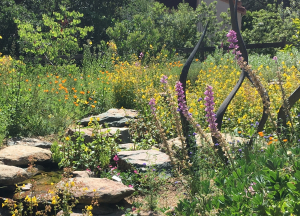
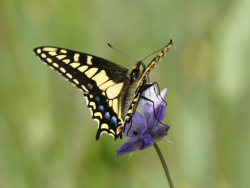 Ready to get started? Here are some simple steps to transform your garden into a welcoming place for birds, butterflies, bees and other wildlife:
Ready to get started? Here are some simple steps to transform your garden into a welcoming place for birds, butterflies, bees and other wildlife:
- How can you restore nature in your garden? Dennis Mudd shares his insights
- Need more information about pollinator plants and bees? Juanita Salisbury answers your questions in this talk.
- Seeking butterfly resources? The Xerces Society is a great resource as well as the Bay Area Wildlife resource website.
- Looking for more native seeds? Check out the great selection at Larner's Seeds. Various mixes are also available from Pacific Coast Seeds.
Getting Started with Native Plants in your Garden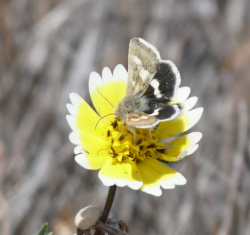
- Need help getting started with a native plant garden? Tips are available in this video
- When should you plant, water, prune, or leave things alone? Helen Popper shares a month-by-month guide for California gardeners.
- What planting methods and soil will ensure success? Haven Kiers from UC Davis shares some research.
- Want to find more California Native plants specific to your area, and the butterflies that use them as host plants? Then check out the wonderful CNPS Calscape website, which includes descriptions and planting information about every California native plant and links to native plant nurseries all over the state. For a user guide to using this amazing resource, watch this talk.
- Check out the great resources on our website and the numerous talks on native plant gardening and native plant science on our YouTube channel.
- Need Plants? Find nurseries, seed stores and plant sales using our list of local retailers.
- Looking for a list of great books for gardening with native plants and for wildlife? Go to our resource page for books.
Activities for Native Plant Gardeners
 Want to do more?
Want to do more?
- Join us on a chapter field trip. See what's coming up here or on our Meetup page.
- Discover flora and fauna in your region and across the globe, and even post your own observations on the iNaturalist app.
- Attend the chapter's annual Growing Natives Garden tour.
- Want to see most of California’s native habitats in one location? Check out the Regional Botanic Garden in Tilden Park.
- Visit other public gardens with native plants. Here's is a list to get you started.
- The CNPS state website also has excellent resources and information to get you started with native plant science or gardening, like Bloom! California.
Where to Buy Native Plants
Here are sources for California native plants in the Bay Area and beyond:
Call before visiting nurseries. All cities are located in California. Also see Calscape and the California Native Plant Link Exchange for additional sources for native plants. |
NURSERIES AND SEED SOURCES
All links will open a new browser window |
| Berkeley Horticultural Nursery |
1310 McGee Avenue
Berkeley 94703
(510) 526-4704 |
Retail with one section devoted to natives. |
| California Flora Nursery |
PO Box 3, Somers and D Street
Fulton 95439
(707) 528 8813 |
Cal Flora is devoted to natives and habitat gardening with an exceptional diversity of offerings. Knowledgeable and experienced with attention to local Bay Area needs and conditions. |
| CNL Native Plant Nursery |
254 Shoreline Highway
Mill Valley, CA 94941
(415) 888-8471 |
Organic, chemical-free, California native plants. Specializes in natural habitat restoration, pollinator friendly plants |
| Capital Wholesale Nursery |
2938 Everdale Drive
San Jose, CA 95148
(408) 239-0589 |
Uncommon perennials, Mediterranean and California natives. Both wholesale and retail |
| Central Coast Wilds |
336 A Golf Club Drive
Santa Cruz 95060
(831) 459-0656 |
California native seeds, plants, revegetation, consulting, and habitat restoration for professionals and home gardeners. |
| CNPS SCV Nursery |
CNPS SCV Nursery at Hidden Villa, Los Altos Hills |
CNPS Santa Clara Valley Chapter's nursery. Public sale in October. Periodic pop-up sales. |
| Curious Flora Nursery |
740 Market Ave.
Richmond, CA 94801
(341) 215-8734 |
Retail and mail order nursery with a large section dedicated to native plants. |
| East Bay Wilds Native Plant Nursery |
28th Ave at Foothill Blvd
Fruitvale District of Oakland
510-409-5858 |
Call for hours. Native plants plus demonstration garden. |
| Grassroots Ecology Native Plant Nursery |
Foothills Park
Palo Alto
650-949-3158 |
Most plants grown from local native stock. Order online and pick up plants at the nursery. |
| Larner Seeds |
PO Box 407
235 Grove Road
Bolinas 94971
(415) 868-9407 |
Mail order seeds and California native wildflowers, perennials, grasses, shrubs, and trees. Demonstration garden. Retail plants at the nursery from October through July. |
| Las Pilitas Nursery |
3232 Las Pilitas Rd
Santa Margarita, CA 93453
(805) 438-5992 |
Mail order and on-site nursery. Extensive native plants list. Excellent descriptions of plants along with planting guidelines. |
| Linda Vista Native Plants |
San Jose.
This email address is being protected from spambots. You need JavaScript enabled to view it. |
Order online with plant pickup in Saratoga. Occasional public sales announced to their email list. |
| Mission Blue Nursery |
1 Mountain Flora Parkway
Brisbane, CA 940056
(415) 467-6631
This email address is being protected from spambots. You need JavaScript enabled to view it. |
Quarterly and by-appointment sales. Mission Blue Nursery grows plants entirely from seeds and cuttings collected on San Bruno Mountain. |
| Mostly Natives Nursery |
54 B Street, Unit D
Point Reyes Station, CA 94956
(415) 663-8835
This email address is being protected from spambots. You need JavaScript enabled to view it. |
Wholesale and retail coastal natives and drought-tolerant plants. Call for open hours. |
| Native Here Nursery |
101 Golf Course Drive in Tilden Regional Park
Berkeley 94708
(510) 549-0211 |
Alameda and Contra Costa County natives. Nursery is operated by East Bay CNPS for East Bay Regional Parks District. Check on website for current hours. |
| Oaktown Native Plant Nursery |
702 Channing Way
Berkeley, CA
(510) 387-9744 |
Retail and wholesale. Offers contract growing for restoration and large landscaping projects. |
| Our City Forest |
1000 Spring St.
San Jose, CA 95110
(408)785-2302 |
Retail |
| Pacific Coast Seed |
533 Hawthorne Place
Livermore 94550
(925) 373-4417 or (800) 733-3462 |
Wholesale or through local nurseries. Wildflower and grass seeds. |
| Payless Nursery |
2927 S. King Road
San Jose 95122
(4080 274-7815 |
This independent nursery devotes a section to a varied selection of native trees, shrubs and perennials. Address your native plant questions to Wanda Olson. |
| Rana Nursery |
7480 Williams Ranch Road
Carmel, CA 93923
(831) 659-3820 |
Native grass seed production and four-acre native plant nursery. Wholesale only. Revegetation, seed, container, and bare root plants. |
| San Diego Chapter, California Native Plant Society seed store |
Contact Form
San Diego, CA
|
Sells California native seeds primarily from Southern California in small quantities for home and demonstration gardens |
| Seedhunt |
PO Box 96
Freedom 95019 |
Mail order annual and perennial seed with hard to find selections and about one-third native |
| Sierra Azul Nursery & Gardens |
2660 East Lake Avenue (Highway 152)
Watsonville 95076
(831) 763 0939 |
Mediterranean, native, and water-conserving plants for California displayed in demonstration gardens as well as the nursery. |
| SummerWinds Nursery |
725 San Antonio Road
Palo Alto, CA 94303
(650) 493-5136 |
Retail. There are several locations, but the Palo Alto store has the best selection of natives. Ask for Judith for assistance. |
| Tree of Life Nursery |
PO Box 635
33201 Ortega Highway
San Juan Capistrano 92693
(949) 728-0685 |
Wholesale and retail. Contract collects and grows. Round House Plant Store has plants and books for home gardener. |
| Watershed Nursery |
601 A Canal Blvd.
Richmond, CA 94804
(510) 234-22225 |
Retail native plants. Contract collects and grows. |
| Yerba Buena Nursery |
12511 San Mateo Rd. (Hwy 92)
Half Moon Bay
(650) 851-1668 |
Retail native plants with some seed. |
NATIVE PLANT SALES
All links will open a new browser window Top of Page |
| Regional Parks Botanic Garden |
Southpark Drive and Wildcat Canyon Road in Tilden Regional Park
Berkeley 94708
(510) 841-8732 |
Check website for sale days and hours. |
| Strybing Arboretum Arboretum and Botanical Gardens |
Golden Gate Park, 9th Ave at Lincoln Way, San Francisco (415) 661-1316 |
Saturday sales with one for natives in the autumn. |
| University of California Berkeley Botanical Garden |
200 Centennial Drive, Berkeley (510) 642-3343 |
Autumn sale with some natives that are hard to find. |
| University of California Santa Cruz Arboretum |
Empire Grade at Western Drive, Santa Cruz (831) 427-2998 |
Joint sale with CNPS Santa Cruz Chapter in April. |
ONLINE SOURCES & RESOURCES
All links will open a new browser window Top of Page |
| California Gardens |
|
Extensive list of California native plants. Pictures and plant descriptions. Ojai, California e-business. |
| California Native Grass Association |
|
Information packets, seed sources, workshops, website resources. Primary focus is grassland restoration, but resource list is broader. |
| El Nativo Growers Inc |
(626) 969-8449 |
Good source of information on natives in the landscape. Wholesale only. |
| San Marcos Growers |
(805) 683-1561 |
This page has links to the database entries for all of the California native plants that they grow and also features articles about native plants and links to other sites that have information about California native plants. The information is written by staff horticulturist Randy Baldwin with contributuions by Carol Bornstein. Wholesale only. |
| The Theodore Payne Foundation for Wildflowers and Native Plants Inc. |
10459 Tuxford Street, Sun Valley 91352 (818) 768-1802 |
Promotes and restores landscapes and habitats, propagates and sells native plants and educates about native plants. Sells native seeds in quantity. |
|
Local Perennial Native Grasses
by Sally Casey, April 1999
| Full Sun Grasses |
| |
| Scientific Name |
Common Name |
Blooms |
Comments |
| |
| Danthonia californica |
California Wild Oat Grass |
Apr - June |
To 40", generally 2½' to 3' |
| Danthonia californica americana |
Hairy California Wild Oat Grass |
Apr - May |
Shorter than species; hairy sheath |
| Festuca idahoensis |
Blue Bunch Grass |
Apr - June |
To 40"; generally lower; open panicle |
| Festuca rubra |
Red Fescue |
May - June |
To 40"; open panicle |
| Hordeum brachyantherum |
Meadow Barley |
Apr - June |
To 28"; inflorescence a spike |
| Koeleria macrantha |
June Grass |
Apr - June |
To 24"; inflorescence an interrupted spike |
| Melica californica |
Western Melica |
Mar - June |
To 52"; generally 3'; dies down in summer |
| Nessella cernua |
Nodding Needle Grass |
Apr - May |
To 3'; inflorescence more delicate than N. pulchra |
| Nesella pulchra |
Purple Needle Grass |
Mar - June |
To 40"; generally 2½' to 3' |
| Poa secunda secunda |
Pine Bluegrass |
Feb - May |
To 40"; generally 24" |
| |
| Partial Sun - Shade Grasses |
| |
| Scientific Name |
Common Name |
Blooms |
Comments |
| |
| Bromus carinatus |
California Brome Annual - Biennial |
Mar - July |
40" - 48"; open panicle |
| Elymus californicus |
California Bottle Brush Grass |
May - July |
To 80"; generally 6' |
| Melica imperfecta |
Small Flowered Melica |
Mar - June |
To 44"; generally 24" - 30"; inflorescence open |
| Melica torreyana |
Torrey's Melica |
Mar - July |
To 40"; generally lower, spreading; inflorescence strict |
| Muhlenbergia rigens |
Deergrass |
June - Sept |
Leaves to 2½' to 3'; spiked inflorescence to 5'; dramatic |
| |
| Shade Grasses |
| |
| Scientific Name |
Common Name |
Blooms |
Comments |
| |
| Bromus laevipes |
Woodland Brome Grass |
May - July |
To 3'; generally lower; inflorescence folded hand |
| Deschampsia elongata |
Slender Hair Grass |
May - July |
Low tuft, inflorescence to 40", generally lower |
| Festuca californica |
California Fescue |
Mar - May |
3' +; open panicle |
| Festuca occidentalis |
Western Fescue |
Apr - July |
To 40"; generally lower; open panicle |
| Hierochloe occidentalis |
California Vanilla Grass |
Jan - May |
To 36"; generally lower |
| Melica geyeri |
Geyer's Onion Grass |
Mar - July |
To 80"; generally 4'; bulbous base |
| Melica subulata |
Alaska Onion Grass |
Mar - July |
To 48"; bulbous base |
| Trisetum canescens |
Tall Trisetum |
May - Aug |
To 32" |
| |
| With one exception (Muhlenbergia rigens), all of the above grasses are found between Route 280 and Skyline. Muhlenbergia rigens grows from Monterey County south, in the central valley, the foothills of and in the Sierra Nevada mountains east to Texas and into Mexico.
CULTURE: Plant 4" or gallon can size in late fall just before the rains. Use compost (but no fertilizer) as a mulch. March is the second-best planting time.
SOURCES: Most of the common names and blooming periods are taken from Thomas' Flora of the Santa Cruz Mountains of California; heights are from Munz' A California Flora; modified heights are my local observations.
|
Native Plantings in Jeffrey Fontana Park
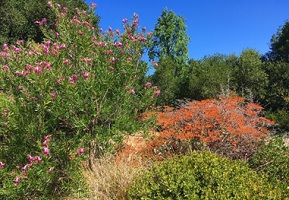 A beautiful selection of mature and new native plant gardens can be found in Jeffry Fontana Park in San Jose. Wandering through the park, you will find plants from both northern and southern California in a variety of settings.
A beautiful selection of mature and new native plant gardens can be found in Jeffry Fontana Park in San Jose. Wandering through the park, you will find plants from both northern and southern California in a variety of settings.
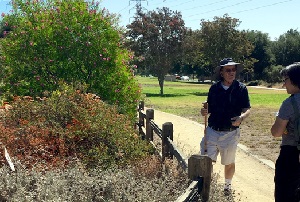 This is the perfect place to view plants that grow well in San Jose and find ideas for your own gardens.
This is the perfect place to view plants that grow well in San Jose and find ideas for your own gardens.
From buckwheats to monkeyflowers to California fuschias, you’ll see something in bloom year-round. Many of the plants are labelled, making it easy to identify your favorites.
The two original berms were planted in 2011 as an alternative landscape feature to tall trees under PG&E power transmission lines. The plants are well-established and no longer need irrigation.
Five Islands

This garden was planted at the beginning of 2018, although the concept was conceived years before. In the words of Patrick Pizzo, its founder:
The concept of the Five Island Project was born about six years ago. We wanted to create islands or berms much like the two that we first introduced into our park, Jeffrey Fontana, as an alternative landscape feature to tall trees, which have impact on the safe delivery of power transmission by PG&E. You see, our two parks, T.J. Martin and J. Fontana are contiguous along the PG&E power transmission easement in south San Jose. Our contribution, toward potential loss of trees, was to develop native plant and shrub alternatives. This was our first effort.
https://www.youtube.com/watch?v=dLGX6CPQBw0
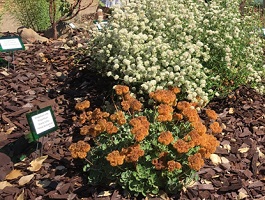 Now near this island is an open area between heritage coast live oak trees, Quercus agrifolia. Our vision was to have a network of islands/berms in this open area. Neighbors wanted to have an alternative to weeds and summer dust storms. The area is about 120 foot by 120 foot. We envisioned five CA native plant islands in this open area.
Now near this island is an open area between heritage coast live oak trees, Quercus agrifolia. Our vision was to have a network of islands/berms in this open area. Neighbors wanted to have an alternative to weeds and summer dust storms. The area is about 120 foot by 120 foot. We envisioned five CA native plant islands in this open area.
 Part of the reason for the passage of time was due to the drought. The City policy became ‘no new plantings’. Then, a couple of years ago, with MFPA postured financially to support a major project, the idea came to the fore and I was asked to implement the proposed project. During the four years leading up to this okay, we had been in multiple conversations with our Parks Department in San Jose about the Five Island Project. About a year ago, we broke ground.
Part of the reason for the passage of time was due to the drought. The City policy became ‘no new plantings’. Then, a couple of years ago, with MFPA postured financially to support a major project, the idea came to the fore and I was asked to implement the proposed project. During the four years leading up to this okay, we had been in multiple conversations with our Parks Department in San Jose about the Five Island Project. About a year ago, we broke ground.
The elongated islands are about 35 by 15 foot and of elliptical shape. The spine is about 2 foot high, tapered to ground level, providing good drainage. The native soil was removed or ‘dished’; and this native dirt (sand and adobe) was mixed with ‘garden soil’ from Evergreen Supply in San Jose. It is the lowest grade of organic soil on the market. The combined soils were used to create the islands/berms. Each island is sponsored, to raise money to implement the project. We have five sponsors: East Bay Wilds, DGDG, Almaden Valley Nursery, PG&E and the past presidents of our organization: MFPA (Martin-Fontana Parks Association):
https://martinfontanaparksassociation.blog

After forming the islands, plants were planted. Each sponsor selected plants and designed their own gardens. Directly after planting, drip-irrigation was installed. We are using Techline drip line with pressure-opened emitters: 1 gallon per hour per emitter. The emitters are spaced 18 inches apart. I designed the irrigation system and will relate at the site-visit. Currently, due to low rain (nothing Jan and Feb), we irrigate every 8 days for 1/2 hour and this is working out fine. We have a variety of water-need plants on the island, by design, so it will be a challenge to fine-tune any summer watering. The islands were planted from mid-Jan through the end of February, which worked out great as you recall the beautiful weather (minus rain). The plants seem very happy with their new homes.
Additional information is available at:
https://martinfontanaparksassociation.blog/2018/06/19/have-you-been-to-the-islands-yet/
Here is a plant list for the five islands.
Directions: The original two berms and the Five Islands area of the park is across from 1278 Oakglen Way, San Jose. Street parking is available.
Capitancillos Drive Native Plant Demonstration Garden
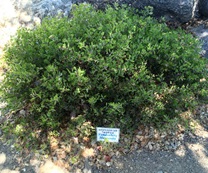 This garden adjoins over a half mile of Capitancillos Drive in San Jose. It is a labor of love by one of the residents of the neighborhood, supported by other neighbors who live along the way. Started in 1995 with the planting of 125 coast live oaks by Our City Forest (http://www.ourcityforest.org/), it has been maintained and filled in with an extensive collection of chaparral shrubs and plants. It blends beautifully with the Guadalupe Creek riparian zone, which is adjacent to the garden.
This garden adjoins over a half mile of Capitancillos Drive in San Jose. It is a labor of love by one of the residents of the neighborhood, supported by other neighbors who live along the way. Started in 1995 with the planting of 125 coast live oaks by Our City Forest (http://www.ourcityforest.org/), it has been maintained and filled in with an extensive collection of chaparral shrubs and plants. It blends beautifully with the Guadalupe Creek riparian zone, which is adjacent to the garden.
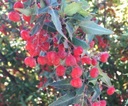 Backed by huge granite boulders and the meadow beyond, the shrubs and trees stand out nicely, yet seem to be part of the natural landscape. The plants are hand-watered until established, by Patrick Pizzo, who designed and installed this impressive garden. Lovely established specimens include a variety of ceanothus and manzanitas, sugar bush, spicebush, bush anenome, mountain mahogany, island bush snapdragon, coast silktassel, lemonade berry, sages, coyote brush, coyote mint, buckwheats, monkeyflowers, silver bush lupine, and much more. Plants are labelled, making it easy to find and identify specific cultivars.
Backed by huge granite boulders and the meadow beyond, the shrubs and trees stand out nicely, yet seem to be part of the natural landscape. The plants are hand-watered until established, by Patrick Pizzo, who designed and installed this impressive garden. Lovely established specimens include a variety of ceanothus and manzanitas, sugar bush, spicebush, bush anenome, mountain mahogany, island bush snapdragon, coast silktassel, lemonade berry, sages, coyote brush, coyote mint, buckwheats, monkeyflowers, silver bush lupine, and much more. Plants are labelled, making it easy to find and identify specific cultivars.
The garden provides food and shelter for wildlife from the adjacent Guadalupe Watershed and Guadalupe Creek. Bluebird nest boxes maintained by the Audubon Society provide additional habitat in the garden.
Here is a plant list for the garden.
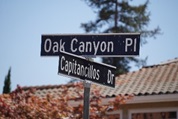
Directions: From Hwy 85, go south on Camden to Coleman. Turn left on Coleman, and left again on Redmond, then right on Oak Canyon Drive. Oak Canyon Drive becomes Oak Canyon Place. Continue to the cul-de-sac and turn about. The garden borders the meadow for 0.6 miles. Ample free parking is available on the street next to the garden.
Native Hill - Update January 2018
Author: Frank Niccoli
Native Hill at Foothill College is enjoying a renaissance. Three years ago, Frank Niccoli, an adjunct instructor at Foothill, envisioned a demonstration garden that would show the community the beauty and wisdom of using California Natives in the garden.
The first step was to install an irrigation system. This installation was made possible by a generous donation by Michelle Chu, the owner of The Village Gardener, Inc., who provided the equipment and a crew to dig the trenches and install the valves, piping and heads. Frank Niccoli designed the system and managed the installation. A total of 48 12” popups with low precipitation nozzles (0.45 gpm) were installed. David Sauter, the Director of the horticulture program at Foothill College, along with the valuable assistance from Mike Diefenback and a crew of student labor, finished the installation.
In the Spring of 2017 the plant installation and maintence class at Foothill pruned plants that had not been touched in years. They removed concrete, trash, an old drip system that never worked and established a rough outline of a pathway. They also installed the first of many plantings and sheet mulched. Niccoli commented, “I cannot wait for the new direction this garden will take. This will enhance the learning experience of the Hort Geeks and the Biology Department Foothill College by giving them a living laboratory.”














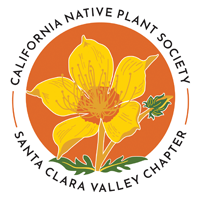

 Late fall and winter are the best times to sow native plant seeds. Online sources offer the widest selection of native plant seeds, but it is possible to find them in local stores. It often takes a little searching to find them -- here are some tips here to help you locate them. If you know of seed sources in the Bay Area that are not included on this page, please send updates to
Late fall and winter are the best times to sow native plant seeds. Online sources offer the widest selection of native plant seeds, but it is possible to find them in local stores. It often takes a little searching to find them -- here are some tips here to help you locate them. If you know of seed sources in the Bay Area that are not included on this page, please send updates to  Many nurseries and even big box hardware stores carry a limited number of native plant seeds and seed mixes, but it can be challenging trying to find packets of seed mixes with only natives as many mixes that include "California" in the name include non-native seeds. It's important to carefully read the list of included flowers before buying. We've identified two native seed mixes that have been spotted in Bay Area stores:
Many nurseries and even big box hardware stores carry a limited number of native plant seeds and seed mixes, but it can be challenging trying to find packets of seed mixes with only natives as many mixes that include "California" in the name include non-native seeds. It's important to carefully read the list of included flowers before buying. We've identified two native seed mixes that have been spotted in Bay Area stores: The most commonly available native plant seeds are California poppies. Since there are many non-native poppies, make sure the botanical name is "Eschscholzia california" when choosing poppy seeds. In addition to the well known orange California poppies, California poppy seeds are available for a rainbow of other colors. Some commonly available ones include:
The most commonly available native plant seeds are California poppies. Since there are many non-native poppies, make sure the botanical name is "Eschscholzia california" when choosing poppy seeds. In addition to the well known orange California poppies, California poppy seeds are available for a rainbow of other colors. Some commonly available ones include:

 Ready to get started? Here are some simple steps to transform your garden into a welcoming place for birds, butterflies, bees and other wildlife:
Ready to get started? Here are some simple steps to transform your garden into a welcoming place for birds, butterflies, bees and other wildlife:
 Want to do more?
Want to do more?  A beautiful selection of mature and new native plant gardens can be found in Jeffry Fontana Park in San Jose. Wandering through the park, you will find plants from both northern and southern California in a variety of settings.
A beautiful selection of mature and new native plant gardens can be found in Jeffry Fontana Park in San Jose. Wandering through the park, you will find plants from both northern and southern California in a variety of settings. This is the perfect place to view plants that grow well in San Jose and find ideas for your own gardens.
This is the perfect place to view plants that grow well in San Jose and find ideas for your own gardens.
 Now near this island is an open area between heritage coast live oak trees, Quercus agrifolia. Our vision was to have a network of islands/berms in this open area. Neighbors wanted to have an alternative to weeds and summer dust storms. The area is about 120 foot by 120 foot. We envisioned five CA native plant islands in this open area.
Now near this island is an open area between heritage coast live oak trees, Quercus agrifolia. Our vision was to have a network of islands/berms in this open area. Neighbors wanted to have an alternative to weeds and summer dust storms. The area is about 120 foot by 120 foot. We envisioned five CA native plant islands in this open area.  Part of the reason for the passage of time was due to the drought. The City policy became ‘no new plantings’. Then, a couple of years ago, with MFPA postured financially to support a major project, the idea came to the fore and I was asked to implement the proposed project. During the four years leading up to this okay, we had been in multiple conversations with our Parks Department in San Jose about the Five Island Project. About a year ago, we broke ground.
Part of the reason for the passage of time was due to the drought. The City policy became ‘no new plantings’. Then, a couple of years ago, with MFPA postured financially to support a major project, the idea came to the fore and I was asked to implement the proposed project. During the four years leading up to this okay, we had been in multiple conversations with our Parks Department in San Jose about the Five Island Project. About a year ago, we broke ground. 
 This garden adjoins over a half mile of Capitancillos Drive in San Jose. It is a labor of love by one of the residents of the neighborhood, supported by other neighbors who live along the way. Started in 1995 with the planting of 125 coast live oaks by Our City Forest (
This garden adjoins over a half mile of Capitancillos Drive in San Jose. It is a labor of love by one of the residents of the neighborhood, supported by other neighbors who live along the way. Started in 1995 with the planting of 125 coast live oaks by Our City Forest ( Backed by huge granite boulders and the meadow beyond, the shrubs and trees stand out nicely, yet seem to be part of the natural landscape. The plants are hand-watered until established, by Patrick Pizzo, who designed and installed this impressive garden. Lovely established specimens include a variety of ceanothus and manzanitas, sugar bush, spicebush, bush anenome, mountain mahogany, island bush snapdragon, coast silktassel, lemonade berry, sages, coyote brush, coyote mint, buckwheats, monkeyflowers, silver bush lupine, and much more. Plants are labelled, making it easy to find and identify specific cultivars.
Backed by huge granite boulders and the meadow beyond, the shrubs and trees stand out nicely, yet seem to be part of the natural landscape. The plants are hand-watered until established, by Patrick Pizzo, who designed and installed this impressive garden. Lovely established specimens include a variety of ceanothus and manzanitas, sugar bush, spicebush, bush anenome, mountain mahogany, island bush snapdragon, coast silktassel, lemonade berry, sages, coyote brush, coyote mint, buckwheats, monkeyflowers, silver bush lupine, and much more. Plants are labelled, making it easy to find and identify specific cultivars.
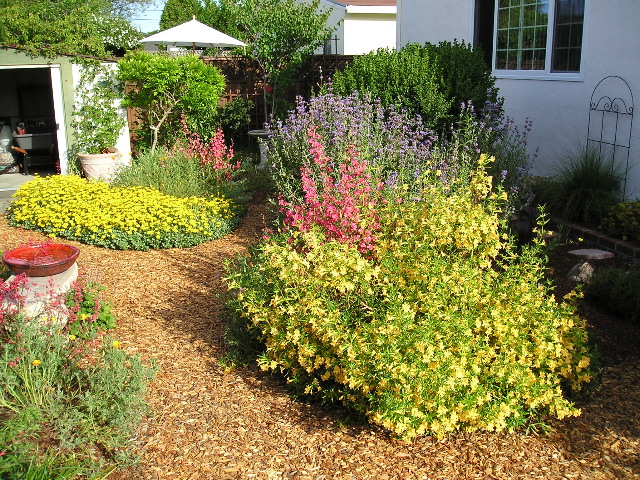 Do you want a garden teeming with life? One that changes with the seasons? One that looks stunning? One that saves water, energy, effort, and money? Consider incorporating California native plants in your garden to attract butterflies, birds, and other wildlife. These beautiful plants will bring seasonal color to your landscape. They will give your California garden a unique sense of place.
Do you want a garden teeming with life? One that changes with the seasons? One that looks stunning? One that saves water, energy, effort, and money? Consider incorporating California native plants in your garden to attract butterflies, birds, and other wildlife. These beautiful plants will bring seasonal color to your landscape. They will give your California garden a unique sense of place.